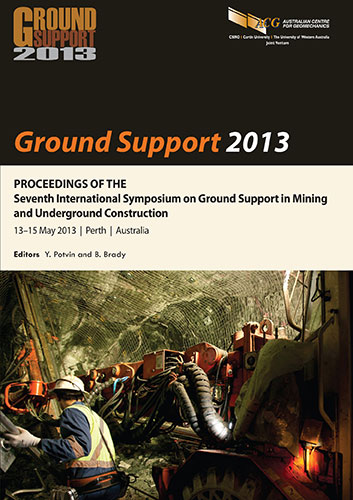Guidelines for the design and construction of underground portals in open pits – a case study of the Gateway Mine

|
Authors: Graaf, JH; Parrott, T |
DOI https://doi.org/10.36487/ACG_rep/1304_28_Graaf
Cite As:
Graaf, JH & Parrott, T 2013, 'Guidelines for the design and construction of underground portals in open pits – a case study of the Gateway Mine', in Y Potvin & B Brady (eds), Ground Support 2013: Proceedings of the Seventh International Symposium on Ground Support in Mining and Underground Construction, Australian Centre for Geomechanics, Perth, pp. 421-436, https://doi.org/10.36487/ACG_rep/1304_28_Graaf
Abstract:
Numerous papers have been written on empirical and deterministic methods of ground support design, yet there is limited published information detailing the application of these methods for underground portals. Newmont Jundee Operation recently started a new underground development called Gateway in the base of an existing pit last mined in the 1990s. Due to the requirements of ventilation and a secondary means of egress, the mine design comprised twin declines from within the existing open pit. To maintain adequate separation between the two portals to avoid ventilation recirculation, the underground design required that one portal be cut in rock of ‘good’ rock mass quality and the second was to be developed through weak, highly weathered materials. This paper describes the process for determining a suitable portal location in an old open pit with the use of mapping, modelling and diamond drilling. In addition to the data collection process, the ground support design, ground support installation and portal excavation methodology for two different types of ground conditions are discussed. In addition to the design process, the lessons learnt from the ground support installation and initial excavation processes are documented so that others planning a new mine can utilise these learnings associated with portal design and construction. It is intended that this paper provides a guideline for engineers for ground support design and selection requirements for a portal. Consideration is also given to the installation process and the practical execution of these requirements.
References:
Barton, N., Lien, R. and Lunde, J. (1974) Engineering Classification of Rock Masses for the Design of Tunnel Support, Rock Mechanics, Vol. 6, No. 4, pp. 183–236.
Cassidy, K.F., Champion, D.C., Krapež, B., Barley, M.E., Brown, S.J.A., Blewett, R.S., Groenewald, P.B. and Tyler, I.M. (2006) A revised geological framework for the Yilgarn Craton, Western Australia: Western Australia Geological Survey, Record 2006/8, 8 p.
Hutchinson, D.J. and Diederichs, M. (1996) Cablebolting in Underground Mines, BiTech Publishers, Richmond, 406 p.
Rogers, G.K. and Haycocks, C. (1989) Rock Classification for portal design, in Proceedings the 30th U.S. Symposium on Rock Mechanics (USRMS), 19–22 June 1989, Morgantown, USA.
Rogers, G.K. and Haycocks, C. (1988) Portal stability in Rock, in Proceedings Seventh International Conference on Ground Control in Mining, 3–5 August 1988, Morgantown, USA, pp. 76–83.
Singh, B., Jethwa, J.L. and Dube, A.K. (1995) A classification system for support pressure in tunnels and caverns, Journal of Rock Mechanics and Tunnelling Technology, Vol. 1(1), pp. 13–24.
Terzaghi, K. (1946) Introduction to tunnel geology, Rock Tunnelling With Steel Supports, R.V. Proctor and T.L. White (eds), Commercial Shearing and Stamping Co., Youngstown, p. 271.
© Copyright 2025, Australian Centre for Geomechanics (ACG), The University of Western Australia. All rights reserved.
View copyright/legal information
Please direct any queries or error reports to repository-acg@uwa.edu.au
View copyright/legal information
Please direct any queries or error reports to repository-acg@uwa.edu.au